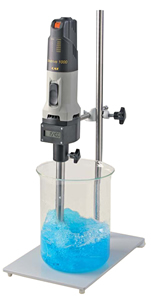Selecting a Digital Display Lab Homogenizer
If operating speed in a laboratory homogenizer is important during process development an obvious purchasing check list includes equipment offering a digital readout of drive motor speed. It provides at a glance the answer to the question “how fast is the generator assembly running?”
The next point to consider is speed options available to the researcher. The variable speed Unidrive X1000D homogenizer available from CAT Scientific offers 6 speed scales ranging from startup at 4,000 RPM to the maximum 33,000 RPM to emulsify, disperse or homogenize sample sizes from 0.2 ml to 5 liters.
Tip: regardless of the desired homogenizer generator speed capability the startup speed should always be at the lowest to avoid possible splashing and loss of sample. It is then ramped up to the desired speed. This is accomplished by using the speed adjustment wheel mounted in the drive motor housing above the on-off switch.
Other Variable Speed Homogenizer Features to Look For
Knowing the processing speed is important but other homogenizing capabilities should also be part of your selection criteria. These are optional features so you can pick and choose what you need based on your homogenizing requirements.
- A mounting system necessary to hold the homogenizer stable when operating. The support rod that comes with the X1000D fits into a steel clamp that is attached to the pedestal stand equipped with a vertical rod. This allows positioning the generator assembly at the correct depth in the sample beaker.
- Universal rotor wrenches that facilitate quick change-out of homogenizing tools
- Homogenizing tools. Select based on the
- length and diameter of the motor-driven shaft and stator tube, the latter of which is clamped firmly to the homogenizer drive motor housing
- generator configuration based on the work to be done and the viscosity of the media. See our post on choosing homogenizer generators.
- other processing equipment such as the DK30 flow through chamber and AX60 analytical mill, both of which are compatible with the X1000D drive motor
Homogenizer Operating and Safety Tips
 We at CAT Scientific strongly encourage new users to read the instruction manual before operating a laboratory homogenizer. Unlike setting up a new TV there is no “quick start.” That said, we offer the following checklist to follow whenever you are using this equipment.
We at CAT Scientific strongly encourage new users to read the instruction manual before operating a laboratory homogenizer. Unlike setting up a new TV there is no “quick start.” That said, we offer the following checklist to follow whenever you are using this equipment.
- The rotor-stator generator assembly must be immersed in the sample before turning on the homogenizer. Otherwise you will damage the generator and the shaft bearings.
- Position the generator offset from the center of the beaker in order to avoid a vortex. A slight offset from true vertical may improve mixing action.
- Keep the generator assembly at least 10mm above the bottom of the beaker.
- The sample depth should not be less than 55mm. If samples are scarce or costly use a test tube and a small-diameter generator assembly.
To avoid buildup of deposits in the homogenizing tool it should be cleaned between operations. For in-depth instructions please read our article on cleaning tips for lab homogenizers along with similar posts on the subject.
Please feel free to contact us at any time for help in selecting the correct CAT homogenizer for your lab and pilot plant operations. A good way to start is filling out our homogenizer questionnaire.
